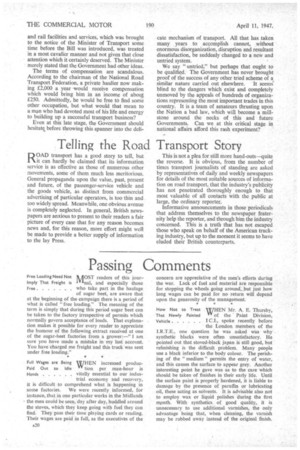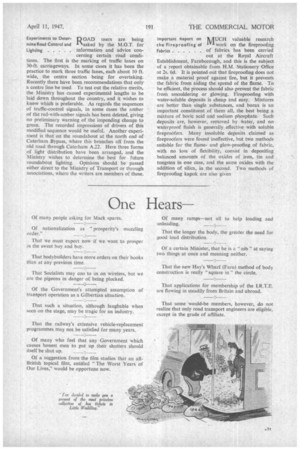Passing Comments
Page 22

Page 23

If you've noticed an error in this article please click here to report it so we can fix it.
Free Loading Need Not MOST readers of this jour– Imply That Freight is "Anal, and especially those
Free who take part in the haulage of sugar beet, are aware that at the beginning of the campaign there is a period of what is called "free loading." The meaning of the term is simply that during this period sugar beet can be taken to the factory irrespective of permits which normally govern acceptance of loads. That explanation makes it possible for every reader to appreciate the humour of the following extract received at one of the sugar-beet factories from a grower:—" I am sure you have made a mistake in my last account. You have charged me freight and this truck was sent under free loading."
Full Wages are Being WHEN increased produc Paid Out to Idle tion per man-hour is Hands vitally essential to our indus
trial economy and recovery, it is difficult to comprehend what is happening in some factories. We were recently informed, for instance, that in one particular works in the Midlands the men could be seen, day after day, huddled around the stoves, which they keep going with fuel they can find. They pass their time playing cards or reading. Their wages are paid in full, as the executives of the concern are appreciative of the men's efforts during the war. Lack of fuel and material are responsible for stopping the wheels going around,.but just how long wages can be paid for no return will depend upon the generosity of the management.
How Not to Treat EN Mr. A. E. Thursby, That Newly Painted of the " Paint Division,
Vehicle I Cl., spoke recently before the London members of the I.R.T.E., one question he was asked was why synthetic blacks were often unsatisfactory. He pointed out that stoved-black japan is still good, but refinishing is the difficult problem. Many people use a black inferior to the body colour. The perishing of the " medium " permits the entry of water, and this causes the surface to appear grey. Another interesting point he gave was as to the care which should be taken of finishes in their early life. Until the surface paint is properly hardened, it is liable to damage by the presence of paraffin or lubricating oil, these acting as solvents. It is advisable also not to employ wax or liquid polishes during the first month. With synthetics of good quality, it is unnecessary to use additional varnishes, the only advantage being that, when cleaning, the varnish may be rubbed away instead of the original finish.
Experiments to DeteriQ OAD users are being mine Road Control and "asked by the M.O.T. for Lighting information and advice con
cerning certain road conditions. The first is the marking of traffic lanes on 30-ft. carriageways. In some cases it has been the practice to mark three traffic lanes,, each about 10 ft. wide, the centre section being for overtaking. Recently there have been recommendations that only a centre line be used. To test out the relative merits, the Ministry has caused experimental lengths to be laid down throughout the country, and it wishes to know which is preferable. As regards the sequences of traffic-control signals, in some cases the amber of the red-with-amber signals has been deleted, giving no preliminary warning of the impending change to green. The recorded impressions of drivers of this modified sequence would be useful. Another experiment is that on the roundabout at the north end of Caterharn Bypass, where this branches off from the old road through Caterham A.22. Here three forms of light distribution have been arranged, and the Ministry wishes to determine the best for future roundabout lighting. Opinions should be passed either direct to the Ministry of Transport or through associations, where the writers are members of these. Important Report on MUCH valuable research the Fireproofing of work on the fireproofing Fabrics of fabrics has been carried
out at the Royal Aircraft Establishment, Farnborough, and this is the subject of a report obtainable from H.M. Stationery Office at 2s. 6d. It is pointed out that fireproofing does not make a material proof against fire, but it prevents the fabric from aiding the spread of the flame. To be efficient, the process should also prevent the fabric from smouldering or glowing. Fireproofing with water-soluble deposits is cheap and easy. Mixtures are better than single substances, and borax is an important constituent of them all, the best being a mixture of boric acid and sodium phosphate. Such deposits are, however, removed by water, and no waterproof finish is generally effective with soluble fireproofers. Many insoluble deposits claimed as fireproofers were found• ineffective, but two methods suitable for the flameand glow-proofing of fabric, with no loss of flexibility, consist in depositing balanced amounts of the. oxides of iron, tin and tungsten in one case, and the same oxides with the addition of silica, in the second. Two methods of fireproofing kapok are also given




































































